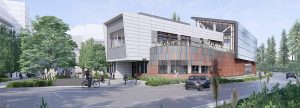
Rendering of the UVic Engineering and Computer Science expansion. Photo credit: Dialog Design
VICTORIA – With growing demand for engineering and computer science programs, the Province and the University of Victoria (UVic) are building new state-of-the-art learning facilities and expanding programs.
This will enable more students to work toward high-impact solutions in fields such as environmental sustainability and health-care technologies.
“Engineers and computer scientists play a critical role as innovators on global challenges such as clean and affordable energy, health care and well-being, and sustainable infrastructure,” said Kevin Hall, president, UVic. “We aim to graduate enterprising people with a social conscience and global perspective, and these new spaces will provide the facilities to nurture highly skilled professionals who will be technological leaders and enrich the local and regional workforce and economy for decades to come.”
With the Province’s support, UVic is expanding its Engineering and Computer Science Building by adding a six-storey addition to provide new laboratory and teaching spaces. This will support 500 additional seats that are currently being added for students in computer science and six engineering programs (biomedical, civil, computer, electrical, mechanical and software), leading to 125 more graduates per year by 2023. Adjacent to that building, a new High Bay Research and Structures Lab will include a 12-metre-high (39-foot-high) area for structural testing and large-scale experiments related to geotechnical, and materials and building-science research essential to the unique work of civil engineers.
“This new space will accelerate UVic’s research discoveries and attract top-tier international scholars and researchers. These landmark buildings will provide a dynamic environment for the training of future engineers and computer scientists. We plan to strengthen Victoria as technology hub by attracting more top talent to UVic and helping position this region as a global centre of excellence,” said Mina Hoorfar, dean of UVic Faculty of Engineering and Computer Science.
Both structures are designed to achieve a net-zero carbon target and will combine Passive House design features and mass timber structure. Other sustainability features include heat pumps and green and solar roofs, enabling students and researchers to experience high-performance green buildings first-hand. The buildings will be at the forefront of green building design and will serve as a living lab for experiential learning, research and industry partnerships, and tackle climate change, clean energy and health-care solutions.
On a global scale, buildings generate almost 40 per cent of greenhouse gas emissions. With this expansion, UVic is responding to the urgent need to aggressively reduce energy demands in the built environment and providing critical space and resources to support the development of high-impact climate solutions.
Construction is expected to begin in early 2022, with building occupancy set for 2024.
Intake for the 500 new seats at UVic began in 2018-19 and will be completed by the 2022-23 academic year.
UVic’s faculty of engineering and computer science currently accommodates approximately 3,000 undergraduates and 600 graduate students across seven streams of study.


